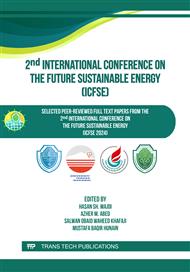[1]
Tuckerman, D.B. and Pease, R.F.W., 1981. High-performance heat sinking for VLSI. IEEE Electron device letters, 2(5), pp.126-129
DOI: 10.1109/EDL.1981.25367
Google Scholar
[2]
Wang, H., Chen, Z. and Gao, J., 2016. Influence of geometric parameters on flow and heat transfer performance of micro-channel heat sinks. Applied Thermal Engineering, 107, pp.870-879
DOI: 10.1016/j.applthermaleng.2016.07.039
Google Scholar
[3]
Rands, C., Webb, B.W. and Maynes, D., 2006. Characterization of transition to turbulence in microchannels. International Journal of Heat and Mass Transfer, 49(17-18), pp.2924-2930
DOI: 10.1016/j.ijheatmasstransfer.2006.02.032
Google Scholar
[4]
Liang, D., Shi, C., Li, W., Chen, W. and Chyu, M.K., 2023. Design, flow characteristics and performance evaluation of bioinspired heat exchangers based on triply periodic minimal surfaces. International Journal of Heat and Mass Transfer, 201, p.123620
DOI: 10.1016/j.ijheatmasstransfer.2022.123620
Google Scholar
[5]
Pradeep, A., Nair, B.G., Suneesh, P.V. and Babu, T.S., 2021. Enhancement in mixing efficiency by ridges in straight and meander microchannels. Chemical Engineering and Processing-Process Intensification, 159, p.108217
DOI: 10.1016/j.cep.2020.108217
Google Scholar
[6]
Stone, H.A. and Kim, S., 2001. Microfluidics: basic issues, applications, and challenges. American Institute of Chemical Engineers. AIChE Journal, 47(6), p.1250
DOI: 10.1002/aic.690470602
Google Scholar
[7]
Garrett, D.E., 2012. Chemical engineering economics. Springer Science & Business Media
DOI: 10.1007/978-94-011-6544-0
Google Scholar
[8]
Nasiri,R., Shamloo,A., Ahadian,S., Amirifar,L., Akbari,J., Goudie M.J., Lee, K., Ashammakhi, N., Dokmeci, M.R., Di Carlo, D. and Khademhosseini,A., 2020. Microfluidic‐based approaches in targeted cell/particle separation based on physical properties: Fundamentals and applications. Small, 16(29), p.2000171
DOI: 10.1002/smll.202000171
Google Scholar
[9]
Whicker, F.W. and Schultz, V., 1982. Radioecology: nuclear energy and the environment (Vol. 1, pp.75-150). Boca Raton, FL: CRC press.
Google Scholar
[10]
Creagh, L.T. and McDonald, M., 2003. Design and performance of inkjet print heads for non-graphic-arts applications. MRS bulletin, 28(11), pp.807-811
DOI: 10.1557/mrs2003.229
Google Scholar
[11]
Ma, K.Q. and Liu, J., 2007. Heat-driven liquid metal cooling device for the thermal management of a computer chip. Journal of Physics D: Applied Physics, 40(15), p.4722. https://
DOI: 10.1088/0022-3727/40/15/055
Google Scholar
[12]
Huang, Y., Lan, Y., Thomson, S.J., Fang, A., Hoffmann, W.C. and Lacey, R.E., 2010. Development of soft computing and applications in agricultural and biological engineering. Computers and electronics in agriculture, 71(2), pp.107-127
DOI: 10.1016/j.compag.2010.01.001
Google Scholar
[13]
Khadra, K., Angot, P., Parneix, S. and Caltagirone, J.P., 2000. Fictitious domain approach for numerical modelling of Navier–Stokes equations. International journal for numerical methods in fluids, 34(8), pp.651-684. https://doi.org/10.1002/1097-0363(20001230)34:8<651::AID-FLD61>3.0.CO;2-D
DOI: 10.1002/1097-0363(20001230)34:8<651::aid-fld61>3.0.co;2-d
Google Scholar
[14]
Siva, V.M., Pattamatta, A. and Das, S.K., 2013. Investigation on flow maldistribution in parallel microchannel systems for integrated microelectronic device cooling. IEEE Transactions on Components, Packaging and ManufacturingTechnology,4(3),pp.438-450. https://
DOI: 10.1109/TCPMT.2013.2284291
Google Scholar
[15]
Guichet, V., Delpech, B. and Jouhara, H., 2023. Experimental investigation, CFD and theoretical modeling of two-phase heat transfer in a three-leg multi-channel heat pipe. International Journal of Heat and Mass Transfer, 203, p.123813
DOI: 10.1016/j.ijheatmasstransfer.2022.123813
Google Scholar
[16]
Kazi, S.N., 2023. Heat Transfer-Fundamentals, Enhancement and Applications
DOI: 10.5772/intechopen.97951
Google Scholar
[17]
Okab, A.K., Hasan, H.M., Hamzah, M., Egab, K., Al-Manea, A. and Yusaf, T., 2022. Analysis of heat transfer and fluid flow in a microchannel heat sink with sidewall dimples and fillet profile. International Journal of Thermofluids, 15, p.100192
DOI: 10.1016/j.ijft.2022.100192
Google Scholar
[18]
Schlichting, H. and Kestin, J., 1961. Boundary layer theory (Vol. 121). New York: McGraw-Hill.
Google Scholar
[19]
Wang, G., Hao, L. and Cheng, P., 2009. An experimental and numerical study of forced convection in a microchannel with negligible axial heat conduction. International Journal of Heat and Mass Transfer, 52(3-4), pp.1070-1074. https://
DOI: 10.1016/j.ijheatmasstransfer.2008.06.038
Google Scholar
[20]
Shepherd, J.F., 2007. Topologic and geometric constraint-based hexahedral mesh generation (Vol. 68, No. 03).
Google Scholar



